Food Safety Practices and Behavior Drivers in Traditional Food Markets in Ethiopia: Assessing the Potential for Consumer-Driven Interventions
Abstract
1. Introduction
2. Materials and Methods
3. Results
3.1. Respondent Demographics
3.2. Consumer Survey
3.2.1. Consumer Food Purchasing Motivations and Behaviors
3.2.2. Consumer Food Safety Knowledge and Beliefs
3.2.3. Consumer Food Safety Choices and Behaviors
3.2.4. Consumer Food Information Sources and Media Use
3.3. Vendor Survey
3.3.1. General Food Vending Practices
3.3.2. Vendor Food Safety Knowledge and Beliefs
3.3.3. Vendor Food Safety Choices and Behaviors
3.3.4. Vendor Information Sources and Media Use
4. Discussion
4.1. Food Purchasing Motivations and Behaviors
4.2. Food Safety Knowledge and Beliefs
4.3. Consumer Food Safety Choices and Behaviors
4.4. Food Information Sources and Media Use
4.5. Study Limitations
5. Conclusions
- Interventions may leverage existing motivations (e.g., consumer demand for quality, or preference for certain shops) to direct or to nudge behaviors towards safer practices while being cognizant of trade-offs (e.g., price vs. quality/safety);
- Practices that currently promote food safety could be reinforced or modified to increase their effectiveness (e.g., keeping food elevated from the ground), while unhelpful practices could be discouraged;
- Existing risk perceptions and beliefs, as well as cues used to assess if a food is safe, could be reinforced when supporting food safety and corrected or deemphasized if not;
- Whether vendors’ awareness of what consumers look for matches actual purchase choice drivers of consumers can determine whether different messages are needed for consumers and vendors;
- External obstacles to carrying out a behavior (e.g., lack of clean water or inability to keep tools at the market overnight) could be addressed by an in-market intervention, as well as by advocacy for infrastructure or policy changes;
- Understanding competition and collaboration dynamics among vendors can direct behavior change strategies (e.g., using food safety as individual competitive advantage versus working in peer groups to uphold higher standards);
- Knowing what media sources individuals use can help select the most effective vehicles for messaging and interactive initiatives;
- Knowing what gender primarily conducts what activities can help determine whether different interventions should be focused towards women and/or men.
- The survey tools tested in this study may be customized and used by other researchers working in food markets or in other food environments.
Supplementary Materials
Author Contributions
Funding
Institutional Review Board Statement
Informed Consent Statement
Data Availability Statement
Acknowledgments
Conflicts of Interest
References
- Havelaar, A.H.; Kirk, M.D.; Torgerson, P.R.; Gibb, H.J.; Hald, T.; Lake, R.J.; Praet, N.; Bellinger, D.C.; de Silva, N.R.; Gargouri, N.; et al. World Health Organization Global Estimates and Regional Comparisons of the Burden of Foodborne Disease in 2010. PLOS Med. 2015, 12, e1001923. [Google Scholar] [CrossRef]
- WHO. WHO Estimates of the Global Burden of Foodborne Diseases; World Health Organization: Geneva, Switzerland, 2015; Available online: https://www.who.int/publications/i/item/9789241565165/ (accessed on 28 February 2025).
- Jaffee, S.; Henson, S.; Unnevehr, L.; Grace, D.; Cassou, E. The Safe Food Imperative: Accelerating Progress in Low-and Middle-Income Countries; The World Bank: Washington, DC, USA, 2018. [Google Scholar]
- Global Alliance for Improved Nutrition (GAIN). Review of Food Safety Policy and Legislation in Ethiopia. EatSafe: Evidence and Action Towards Safe, Nutritious Food. 2022. Available online: https://www.gainhealth.org/sites/default/files/publications/documents/Review%20of%20Food%20Safety%20Policy%20in%20Ethiopia.pdf (accessed on 28 February 2025).
- Grace, D. Food Safety in Low and Middle Income Countries. Int. J. Environ. Res. Public. Health 2015, 12, 10490–10507. [Google Scholar] [CrossRef]
- Ayalew, H. Review on food safety system: Ethiopian perspective. Afr. J. Food Sci. 2013, 7, 431–440. [Google Scholar] [CrossRef]
- Roesel, K.; Grace, D. Food Safety and Informal Markets: Animal Products in Sub-Saharan Africa; Routledge: London, UK, 2014. [Google Scholar]
- Nordhagen, S.; Hagos, S.; Gebremedhin, G.; Lee, J. Vendor capacity and incentives to supply safer food: A perspective from urban Ethiopia. Food Secur. 2025, 17, 331–344. [Google Scholar] [CrossRef]
- Grace, D.; Dipeolu, M.; Alonso, S. Improving food safety in the informal sector: Nine years later. Infect. Ecol. Epidemiol. 2019, 9, 1579613. [Google Scholar] [CrossRef] [PubMed]
- Parikh, P.; Aparo, N.O.; Nordhagen, S.; De Steur, H. Food safety-related perspectives and practices of consumers and vendors in Ethiopia: A scoping review. Food Res. Int. 2022, 157, 111376. [Google Scholar] [CrossRef]
- Nordhagen, S.; Hagos, S.; Gebremedhin, G.; Lee, J. Understanding consumer beliefs and choices related to food safety: A qualitative study in urban Ethiopia. Public Health Nutr. 2024, 27, e239. [Google Scholar] [CrossRef]
- Isanovic, S.; Constantinides, S.V.; Frongillo, E.A.; Bhandari, S.; Samin, S.; Kenney, E.; Wertheim-Heck, S.; Nordhagen, S.; Holdsworth, M.; Dominguez-Salas, P.; et al. How Perspectives on Food Safety of Vendors and Consumers Translate into Food-Choice Behaviors in 6 African and Asian Countries. Curr. Dev. Nutr. 2023, 7, 100015. [Google Scholar] [CrossRef]
- Lazaro, J.; Kapute, F.; Holm, R.H. Food safety policies and practices in public spaces: The urban water, sanitation, and hygiene environment for fresh fish sold from individual vendors in Mzuzu, Malawi. Food Sci. Nutr. 2019, 7, 2986–2994. [Google Scholar] [CrossRef]
- Global Alliance for Improved Nutrition (GAIN). Qualitative Behavioral Research in Traditional Markets in Kebbi State, Nigeria. EatSafe: Evidence and Action Towards Safe, Nutritious Food. 2022. Available online: https://www.gainhealth.org/resources/reports-and-publications/qualitative-behavioral-research-traditional-food-markets-kebbi (accessed on 28 February 2025).
- Bass, S.B.; Brajuha, J.; Kelly, P.J.; D’Avanzo, P.; Lambertini, E.; Nordhagen, S.; Monterrosa, E.C. Changing Behavior, Attitudes, and Beliefs About Food Safety: A Scoping Review of Interventions Across the World and Implications for Empowering Consumers. Foodborne Pathog. Dis. 2022, 19, 19–30. [Google Scholar] [CrossRef] [PubMed]
- USAID Advancing Nutrition. Methods, Tools, and Metrics for Evaluating Market Food Environments in Low-and Middle-Income Countries; USAID Advancing Nutrition: Arlington, VA, USA, 2021. [Google Scholar]
- Turner, C.; Kalamatianou, S.; Drewnowski, A.; Kulkarni, B.; Kinra, S.; Kadiyala, S. Food Environment Research in Low- and Middle-Income Countries: A Systematic Scoping Review. Adv. Nutr. 2020, 11, 387–397. [Google Scholar] [CrossRef]
- Global Alliance for Improved Nutrition (GAIN). EatSafe Learnings from Phase I Research in Hawassa, Ethiopia. EatSafe: Evidence and Action Towards Safe, Nutritious Food. 2023. Available online: https://www.gainhealth.org/sites/default/files/publications/documents/EatSafe-Learnings-from-Phase-I-Research-in-Ethiopia.pdf (accessed on 28 February 2025).
- Gazu, L.; Alonso, S.; Mutua, F.; Roesel, K.; Lindahl, J.F.; Amenu, K.; Maximiano Sousa, F.; Ulrich, P.; Guadu, T.; Dione, M.; et al. Foodborne Disease Hazards and Burden in Ethiopia: A Systematic Literature Review, 1990–2019. 2022. Available online: https://cgspace.cgiar.org/handle/10568/120999 (accessed on 27 June 2023).
- Global Alliance for Improved Nutrition (GAIN). Literature Review on Foodborne Disease Hazards in Food and Beverages in Ethiopia. EatSafe: Evidence and Action Towards Safe, Nutritious Food. 2022. Available online: https://www.gainhealth.org/sites/default/files/publications/documents/Literature%20Review%20on%20Foodborne%20Disease%20Hazards%20in%20Foods%20and%20Beverages%20in%20Ethiopia.pdf (accessed on 28 February 2025).
- Global Alliance for Improved Nutrition (GAIN). Food Safety Hazards and Risk Associated with Fresh Vegetables: Assessment from a Traditional Market in Southern Ethiopia. 2023. Available online: https://www.gainhealth.org/sites/default/files/publications/documents/Food_Safety_Hazards_Risk_Fresh_Vegetables_%20Traditional_Market_Southern_Ethiopia.pdf (accessed on 28 February 2025).
- Hsieh, F.Y.; Liu, A.A. Adequacy of sample size in health studies. Stanley Lemeshow, David W. Hosmer Jr., Janelle Klar and Stephen K. Lwanga published on behalf of WHO by Wiley, Chichester, 1990. No. of pages: xii + 233. Price:£D17.50. Stat. Med. 1990, 9, 1382. [Google Scholar] [CrossRef]
- StataCorp. Stata Statistical Software: Release 17; StataCorp LLC.: College Station, TX, USA, 2021. [Google Scholar]
- The R Core Team. R: A Language and Environment for Statistical Computing; R Foundation for Statistical Computing: Vienna, Austria, 2022; Available online: https://www.R-project.org (accessed on 28 February 2025).
- Poverty Probability Index. Ethiopia. In: PPI [Internet]. 2020. Available online: https://www.povertyindex.org/country/ethiopia (accessed on 6 October 2022).
- Misra, S.; Li, H.; He, J. Machine Learning for Subsurface Characterization; Gulf Professional Publishing, an imprint of Elsevier: Cambridge, MA, USA, 2020. [Google Scholar]
- Osafo, R.; Balali, G.I.; Amissah-Reynolds, P.K.; Gyapong, F.; Addy, R.; Nyarko, A.A.; Wiafe, P. Microbial and Parasitic Contamination of Vegetables in Developing Countries and Their Food Safety Guidelines. J. Food Qual. 2022, 2022, e4141914. [Google Scholar] [CrossRef]
- Jaffee, S.; Henson, S. Promoting Food Safety in the Informal Markets of Low and Middle-Income Countries: The Need for a Rethink. Food Prot. Trends 2024, 44, 376–382. [Google Scholar]
- Rheinländer, T.; Olsen, M.; Bakang, J.A.; Takyi, H.; Konradsen, F.; Samuelsen, H. Keeping up appearances: Perceptions of street food safety in urban Kumasi, Ghana. J. Urban Health 2008, 85, 952–964. [Google Scholar] [CrossRef]
- Nordhagen, S.; Lee, J.; Onuigbo-Chatta, N.; Okoruwa, A.; Monterrosa, E.; Lambertini, E.; Pelto, G.H. “Sometimes You Get Good Ones, and Sometimes You Get Not-so-Good Ones”: Vendors’ and Consumers’ Strategies to Identify and Mitigate Food Safety Risks in Urban Nigeria. Foods 2022, 11, 201. [Google Scholar] [CrossRef]
- Lee, J.; Pelto, G.H.; Nordhagen, S. Beliefs, values, and sociocultural patterns related to food safety in low- and middle-income countries: A synthesis of the descriptive ethnographic literature. Appetite 2022, 178, 106265. [Google Scholar] [CrossRef] [PubMed]
- Global Alliance for Improved Nutrition (GAIN). Leveraging Consumer Demand to Drive Food Safety Improvements in Traditional Markets: FTF EatSafe’s Research & Implementation Results. Available online: https://www.gainhealth.org/resources/reports-and-publications/leveraging-consumer-demand-drive-food-safety-improvements (accessed on 28 February 2025).
- Noor, A.Y.M.; Toiba, H.; Setiawan, B.; Wahib Muhaimin, A.; Nurjannah, N. Indonesian Consumers’ Preferences and Willingness to Pay for Certified Vegetables: A Choice-Based Conjoint Approach. J. Int. Food Agribus. Mark. 2024, 36, 617–642. [Google Scholar] [CrossRef]
- Hoffmann, V.; Moser, C.M.; Herrman, T.J. Demand for Aflatoxin-Safe Maize in Kenya: Dynamic Response to Price and Advertising. Am. J. Agric. Econ. 2021, 103, 275–295. [Google Scholar] [CrossRef]
- Owusu-Sekyere, E.; Owusu, V.; Jordaan, H. Consumer preferences and willingness to pay for beef food safety assurance labels in the Kumasi Metropolis and Sunyani Municipality of Ghana. Food Control 2014, 46, 152–159. [Google Scholar] [CrossRef]
- Alimi, B.A.; Oyeyinka, A.T.; Olohungbebe, L.O. Socio-economic characteristics and willingness of consumers to pay for the safety of fura de nunu in Ilorin, Nigeria. Qual. Assur. Saf. Crops Foods 2016, 8, 81–86. [Google Scholar] [CrossRef]
- Wongprawmas, R.; Canavari, M. Consumers’ willingness-to-pay for food safety labels in an emerging market: The case of fresh produce in Thailand. Food Policy 2017, 69, 25–34. [Google Scholar] [CrossRef]
- Alphonce, R.; Alfnes, F. Consumer willingness to pay for food safety in Tanzania: An incentive-aligned conjoint analysis. Int. J. Consum. Stud. 2012, 36, 394–400. [Google Scholar] [CrossRef]
- Alimi, B.A.; Workneh, T.S. Consumer awareness and willingness to pay for safety of street foods in developing countries: A review. Int. J. Consum. Stud. 2016, 40, 242–248. [Google Scholar] [CrossRef]
- Vuong, H.; Pannell, D.; Schilizzi, S.; Burton, M. Vietnamese consumers’ willingness to pay for improved food safety for vegetables and pork. Aust. J. Agric. Resour. Econ. 2024, 68, 948–972. [Google Scholar] [CrossRef]
- Zhong, S.; Werner, C. The hidden strength of small business: Social networks and wet market vendors in China. Econ. Anthropol. 2025, 12, e12323. [Google Scholar] [CrossRef]
- Nordhagen, S.; Lee, J.; Monterrosa, E.; Onuigbo-Chatta, N.; Okoruwa, A.; Lambertini, E.; Pelto, G.H. Where supply and demand meet: How consumer and vendor interactions create a market, a Nigerian example. Food Secur. 2023, 15, 1505–1519. [Google Scholar] [CrossRef]
- Nordhagen, S.; Onuigbo-Chatta, N.; Lambertini, E.; Wenndt, A.; Okoruwa, A. Perspectives on food safety across traditional market supply chains in Nigeria. Food Humanit. 2023, 1, 333–342. [Google Scholar] [CrossRef]
- Wenndt, A.; Nordhagen, S.; Okoruwa, A.; Onuigbo-Chatta, N.; Swartz, H.; Andohol, P.; Igho, S.; Lambertini, E. Food safety through the eyes of rural market vendors in northwest Nigeria. J. Rural. Stud. 2025, 114, 103527. [Google Scholar] [CrossRef]
- Hennessey, M.; Kim, S.; Unger, F.; Nguyen-Viet, H.; Dang-Xuan, S.; Nguyen-Thi, T.; Häsler, B. Exploring the potential of using nudges to promote food hygiene in the pork value chain in Vietnam. Prev. Vet. Med. 2020, 181, 105003. [Google Scholar] [CrossRef]
- Wallace, F.; Mittal, N.; Lambertini, E.; Nordhagen, S. Vendor Knowledge, Attitudes, and Practices Related to Food Safety in Low- and Middle-Income Countries: A Scoping Review. J. Food Prot. 2022, 85, 1069–1078. [Google Scholar] [CrossRef] [PubMed]
- Global Alliance for Improved Nutrition (GAIN). Food Safety Attitudes and Practices in Traditional Markets in Nigeria: A Quantitative Formative Assessment. 2022. Available online: https://www.gainhealth.org/resources/reports-and-publications/food-safety-attitudes-and-practices-traditional-markets-nigeria (accessed on 2 December 2024).
- Global Alliance for Improved Nutrition (GAIN). Food Safety Perceptions and Practices in Ethiopia: A Focused Ethnographic Study. Available online: https://www.gainhealth.org/resources/reports-and-publications/food-safety-perceptions-and-practices-ethiopia-focused (accessed on 28 February 2025).
- Global Alliance for Improved Nutrition (GAIN). Evaluation of Consumer and Vendor Behaviors in a Traditional Food Market in Hawassa, Ethiopia. EatSafe: Evidence and Action Towards Safe, Nutritious Food. 2022. Available online: https://www.gainhealth.org/sites/default/files/publications/documents/Evaluation%20of%20Consumer%20and%20Vendor%20Behaviors%20in%20a%20Traditional%20Food%20Market%20in%20Hawassa%2C%20Ethiopia.pdf (accessed on 28 February 2025).
- Ghatak, S.; Srinivas, K.; Milton, A.A.P.; Priya, G.B.; Das, S.; Lindahl, J.F. Limiting the spillover of zoonotic pathogens from traditional food markets in developing countries and a new market design for risk-proofing. Epidemiol. Health 2023, 45, e2023097. [Google Scholar] [CrossRef] [PubMed]
- Global Alliance for Improved Nutrition (GAIN). Leveraging Consumer Demand to Drive Food Safety Improvements in Traditional Markets—An Activity Implementation Guide. 2024. Available online: https://www.gainhealth.org/sites/default/files/publications/documents/intervention-implementation-guide.pdf (accessed on 28 February 2025).
- Global Alliance for Improved Nutrition (GAIN). Rapid Market Assessment Tool for Food Safety in Traditional Markets. 2024. Available online: https://www.gainhealth.org/resources/reports-and-publications/rapid-market-assessment-tool-food-safety-traditional-markets (accessed on 28 February 2025).
- Global Alliance for Improved Nutrition (GAIN). Market Assessment Tools for Traditional Markets. 2024. Available online: https://www.gainhealth.org/resources/reports-and-publications/market-assessment-tools-traditional-markets (accessed on 28 February 2025).
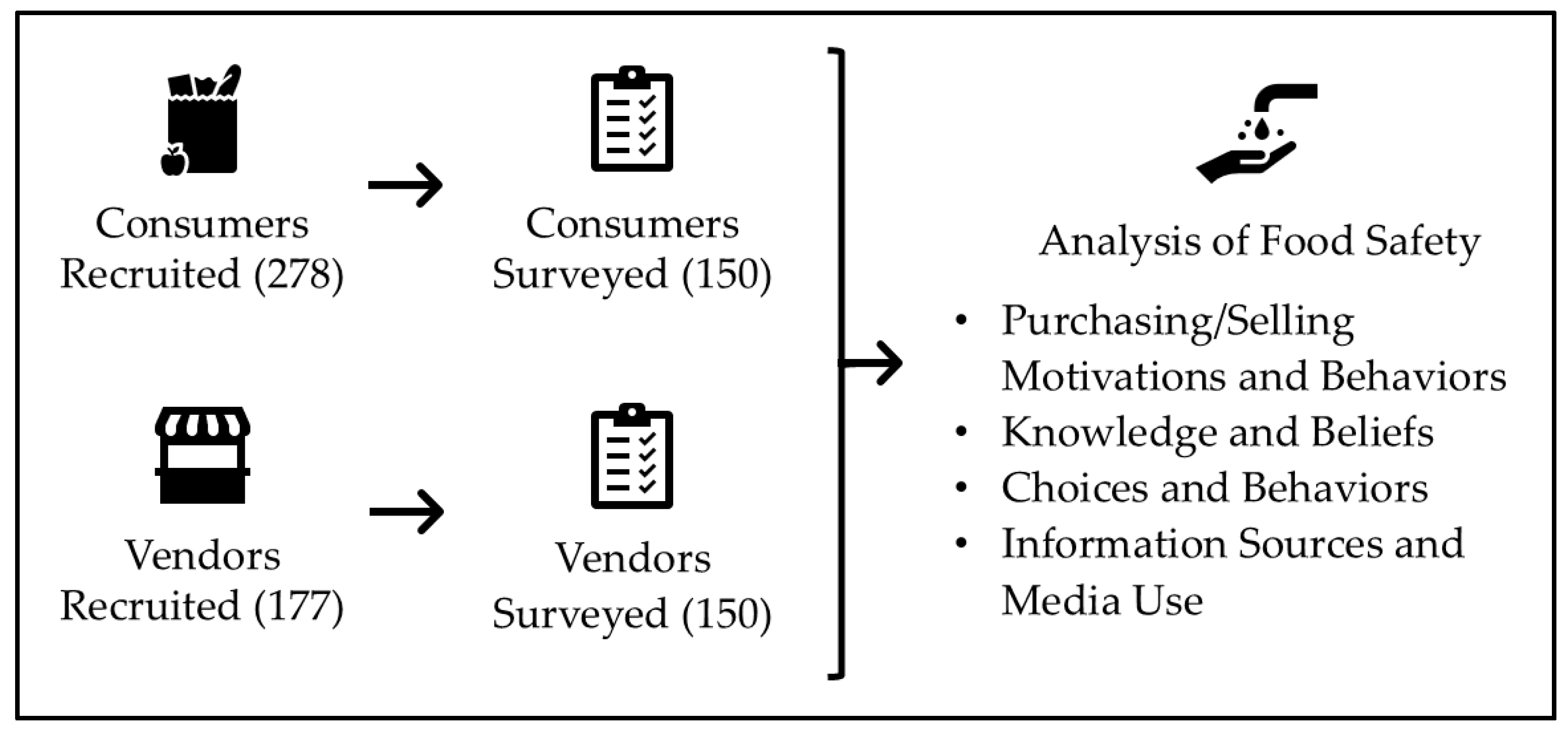

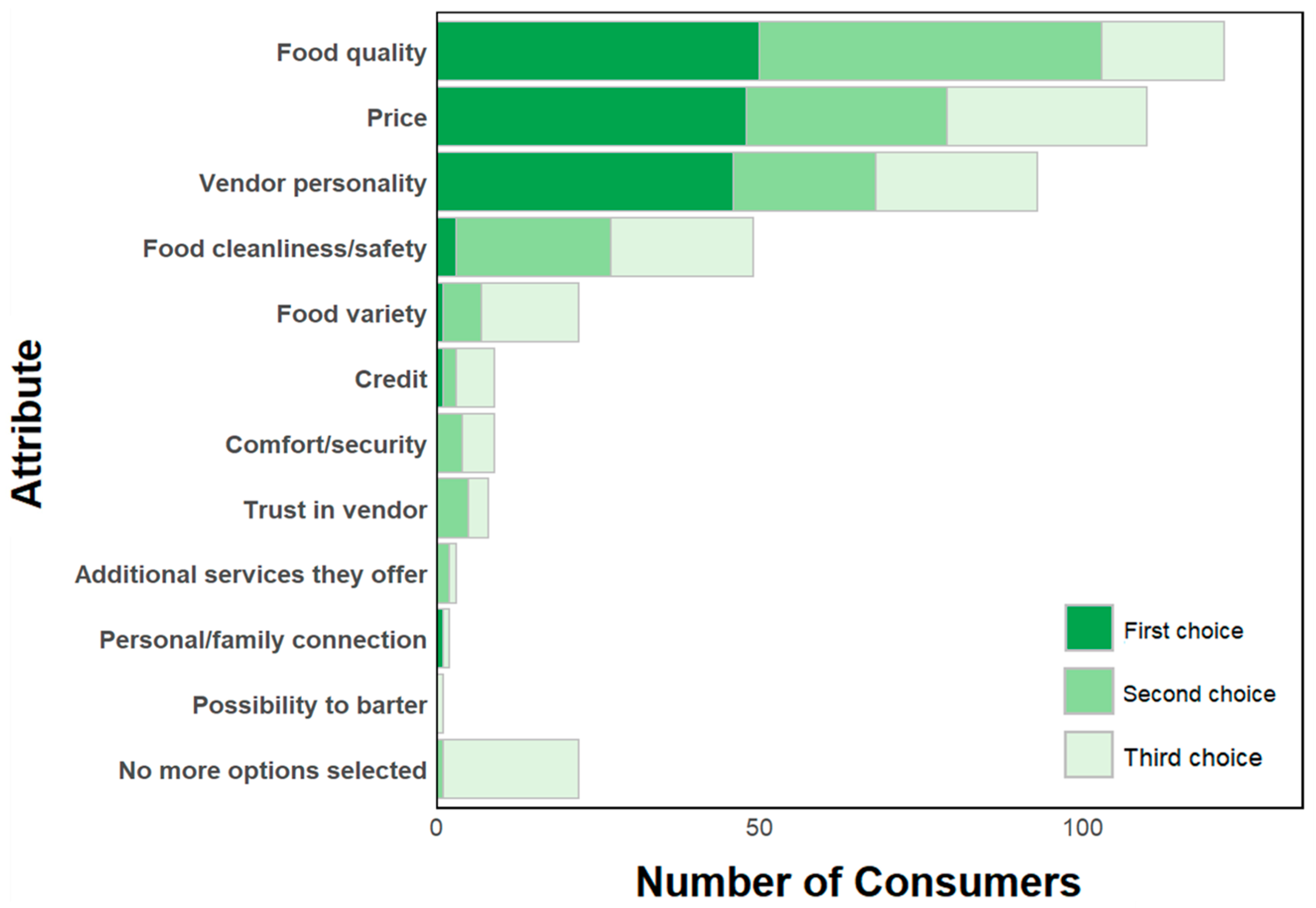
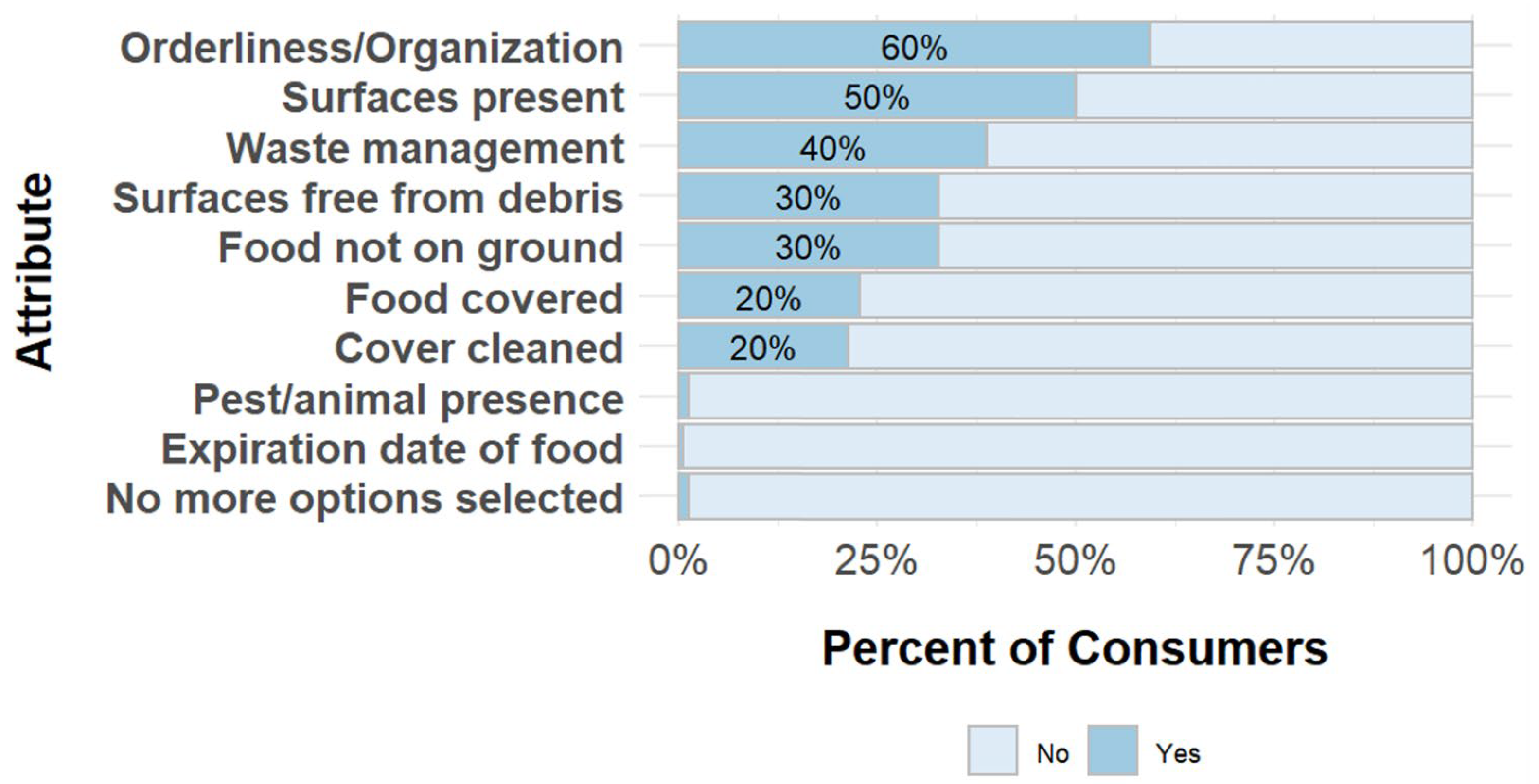
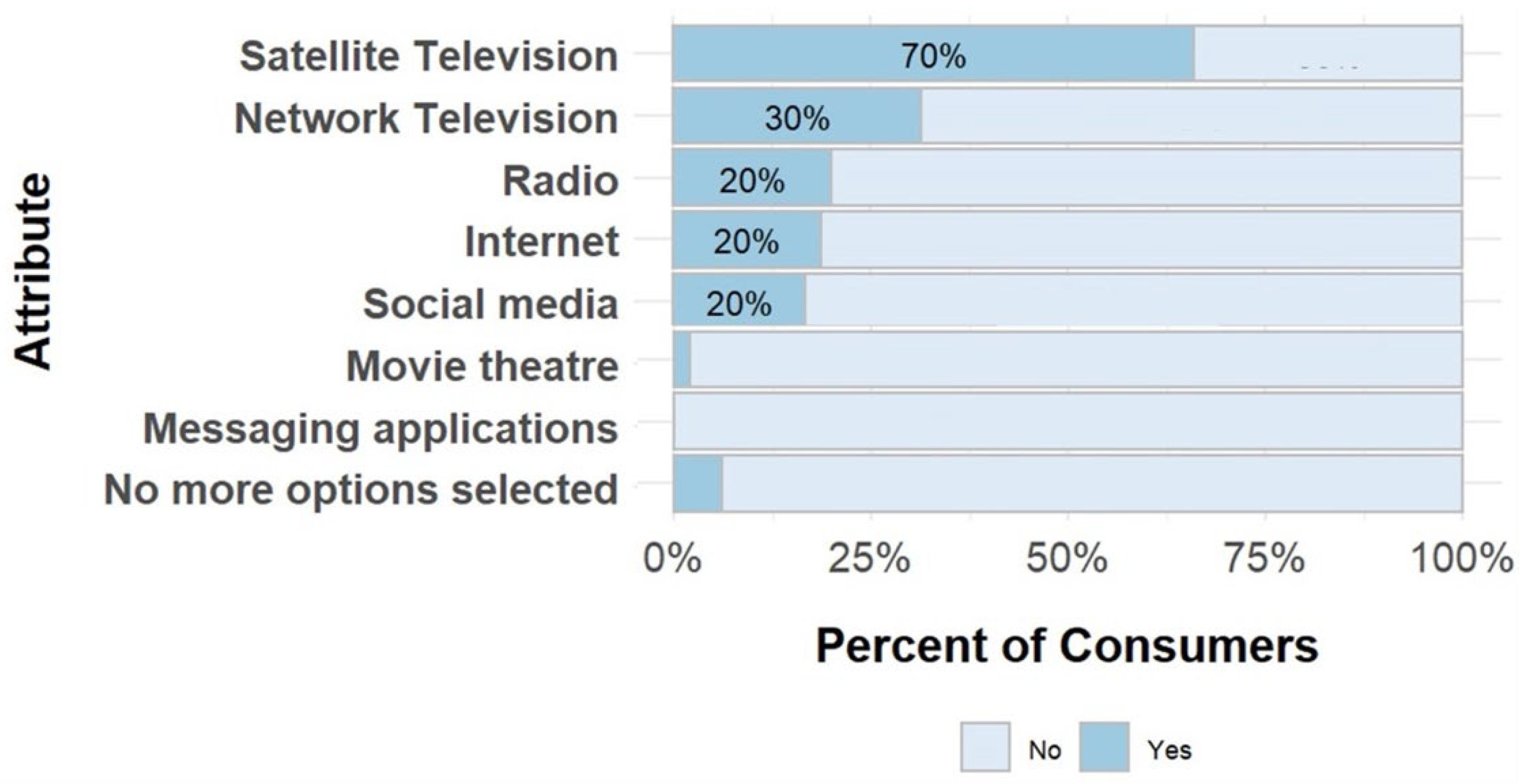
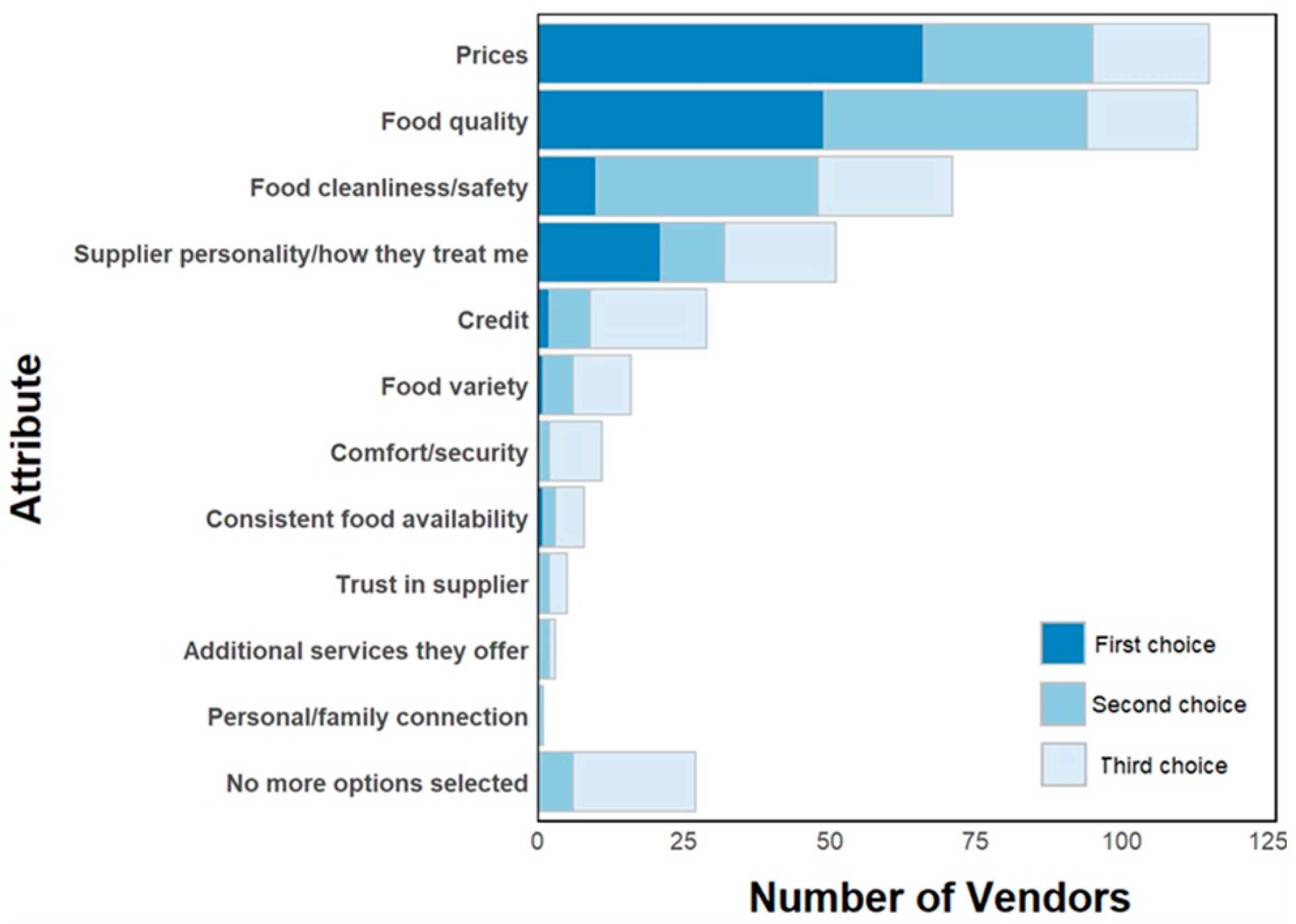
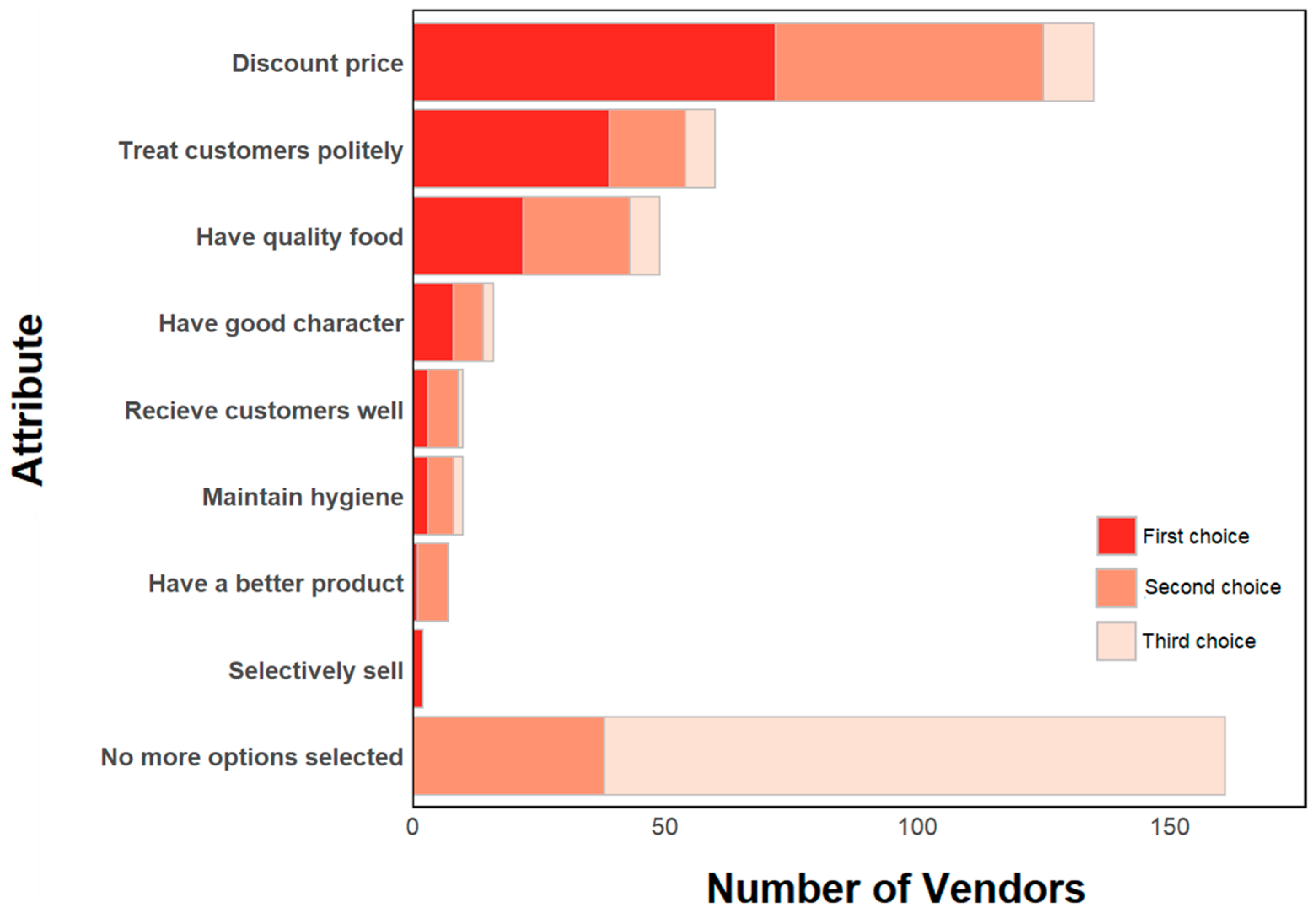
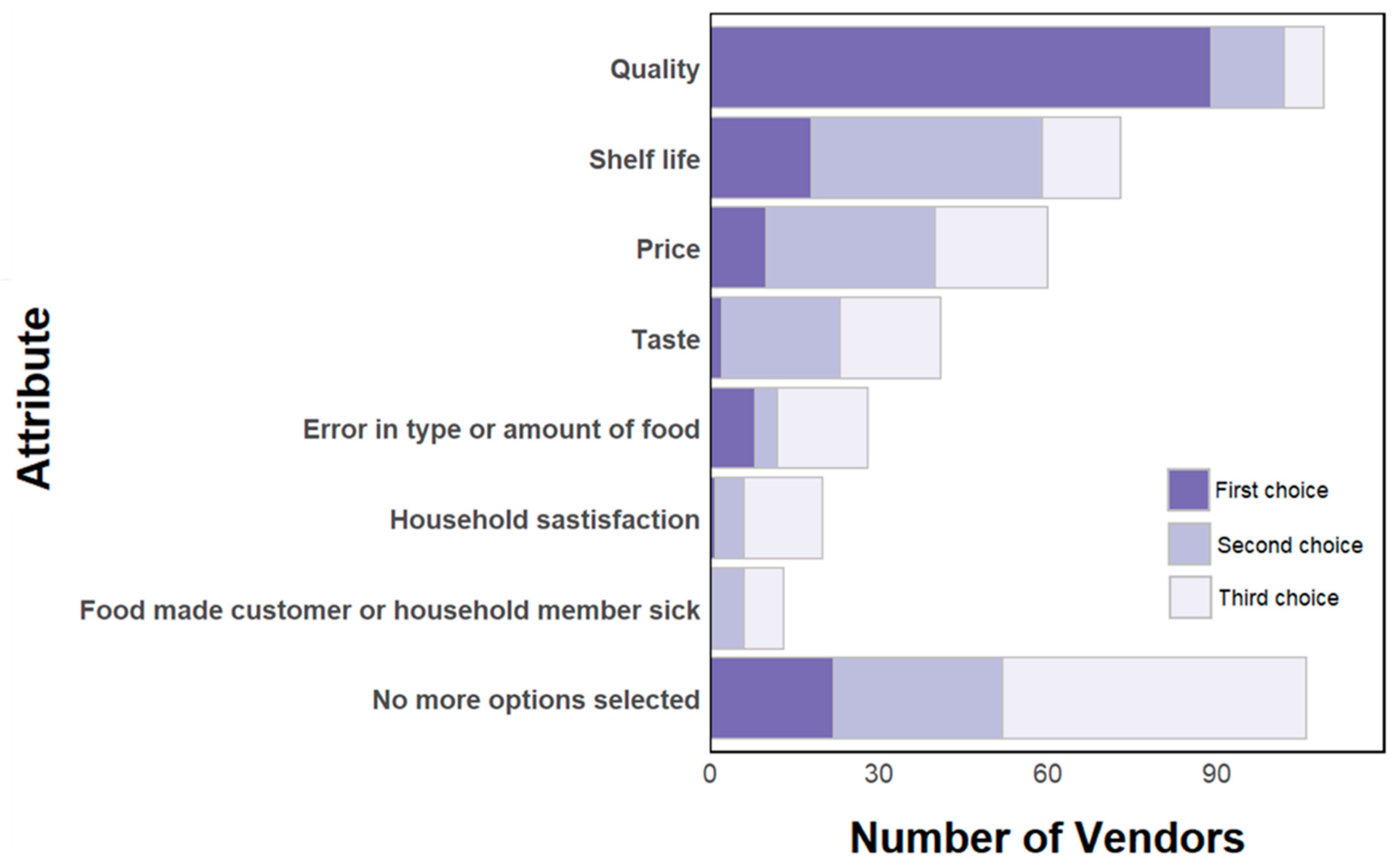
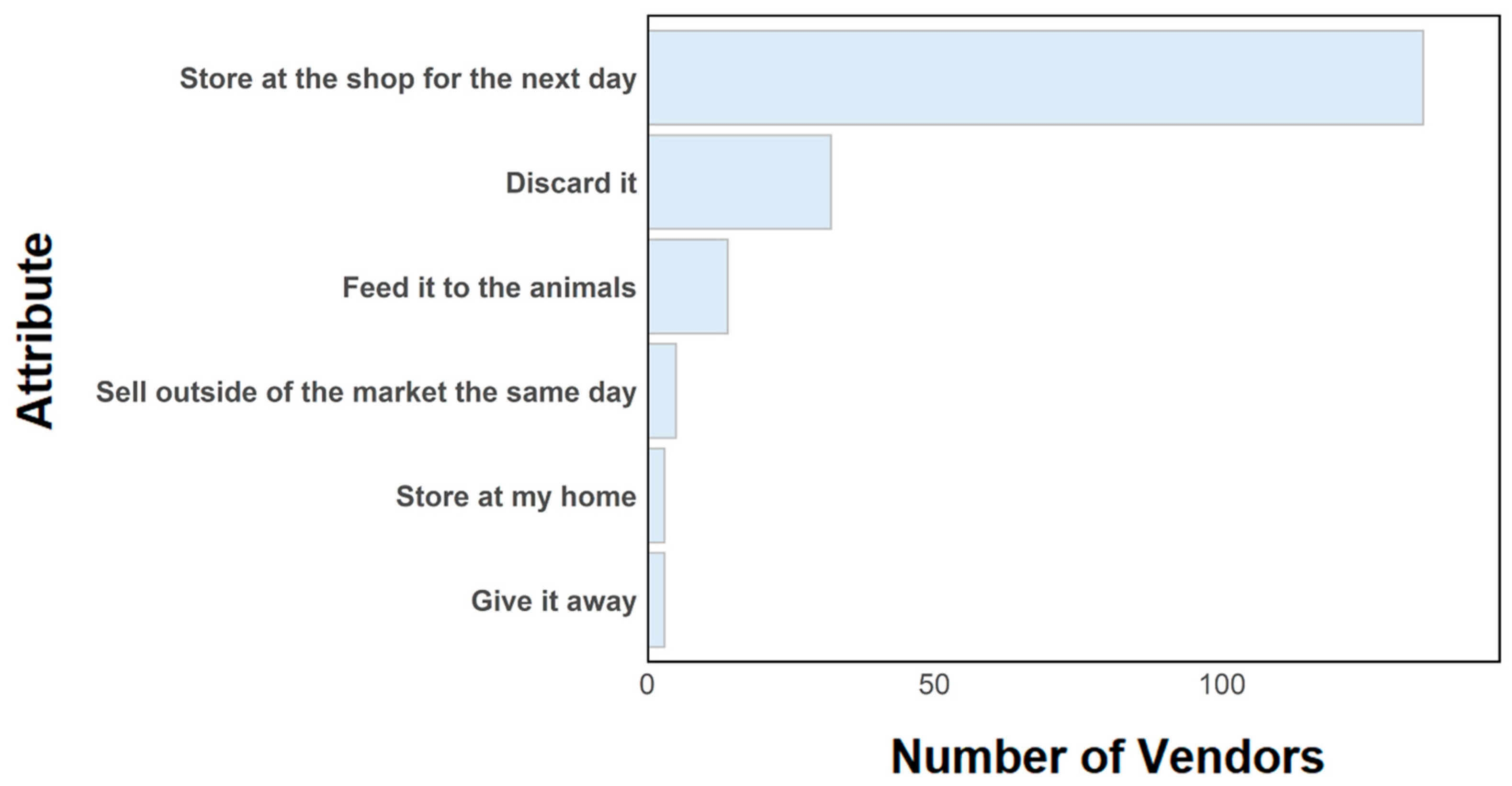
| Characteristic | Category | Demographics | |
|---|---|---|---|
| Vendors (N = 150) | Consumers (N = 150) | ||
| Mean (SD) | Mean (SD) | ||
| Number of household residents | 5.1 (2) | 4.7 (2.1) | |
| Number of household residents <5 years of age | 0.6 (0.8) | 0.5 (0.7) | |
| Age (years) | 30.5 (11) | 32 (10) | |
| N (%) | N (%) | ||
| Sex | Men | 22 (15%) | 52 (35%) |
| Women | 128 (85%) | 98 (65%) | |
| Marital Status | Married | 109 (73%) | 94 (63%) |
| Not married | 32 (21%) | 47 (31%) | |
| Education 1 | Divorced | 3 (2%) | 4 (3%) |
| Widowed | 6 (4%) | 5 (3%) | |
| Primary (0–4th Grade) | 32 (21%) | 12 (8%) | |
| Secondary (5–12th Grade) | 94 (63%) | 78 (52%) | |
| Post-secondary | 5 (3%) | 44 (29%) | |
| Post-secondary (tvet) 2 | 4 (3%) | 9 (6%) | |
| Never attended school (illiterate) | 12 (8%) | 3 (2%) | |
| Language 3 | Amharic | 87 (58%) | 118 (79%) |
| Sidama | 6 (4%) | 12 (8%) | |
| Wolayita | 55 (37%) | 16 (11%) | |
| Responses | Responses, by Gender | |||
|---|---|---|---|---|
| Foods 1 | N | % 1 | Men N (%) 2 | Women N (%) 2 |
| Tomatoes | 139 | 93% | 49 (35%) | 90 (65%) |
| Leafy greens | 126 | 84% | 38 (30%) | 88 (70%) |
| Roots/tubers | 80 | 53% | 26 (33%) | 54 (68%) |
| Legumes | 66 | 44% | 19 (29%) | 47 (71%) |
| Eggs | 25 | 17% | 7 (28%) | 18 (72%) |
| Poultry | 21 | 14% | 6 (29%) | 15 (71%) |
| Grains | 17 | 11% | 1 (6%) | 16 (94%) |
| Milk or Dairy Products | 9 | 6% | 0 (0%) | 9 (6%) |
| Perception | Agreement | ||||
|---|---|---|---|---|---|
|
Strongly
Disagree | Disagree | Neither Agree nor Disagree | Agree | Strongly Agree | |
| People get sick from eating kale | 19% | 55% | 10% | 15% | 1% |
| People get sick from eating lettuce | 15% | 61% | 11% | 13% | 1% |
| People get sick from eating tomatoes | 15% | 47% | 13% | 23% | 2% |
| Food safety differs between vendors | 3% | 10% | 11% | 65% | 10% |
| Trust that vendors sell safe food | 3% | 15% | 10% | 63% | 9% |
|
Prefer to buy from vendors that have a food safety certification or license
(if available) | 6% | 28% | 5% | 49% | 13% |
| Media | Responses | Responses, by Gender | ||
|---|---|---|---|---|
| N | % 1 | Men, N (%) 2 | Women, N (%) 2 | |
| Medical professional (doctor/nurse) | 100 | 67% | 34 (34%) | 66 (66%) |
| Friends or family | 94 | 63% | 35 (37%) | 59 (63%) |
| Food packaging/labels | 71 | 47% | 27 (38%) | 44 (62%) |
| Experts on the radio or TV | 50 | 33% | 22 (44%) | 28 (56%) |
| Internet/social media | 44 | 29% | 16 (36%) | 28 (64%) |
| Journalists (newspaper)/show hosts (TV/radio) | 24 | 16% | 12 (50%) | 12 (50%) |
| Local religious leader | 15 | 10% | 6 (40%) | 9 (60%) |
| A famous person you like | 9 | 6% | 6 (67%) | 3 (33%) |
| Government agencies | 4 | 3% | 1 (25%) | 3 (75%) |
| Perception | Agreement | ||||
|---|---|---|---|---|---|
| Strongly Disagree % (N) | Disagree % (N) | Neither % (N) | Agree % (N) | Strongly Agree % (N) | |
| Can find suppliers that sell high-quality foods | 2% (3) | 4% (6) | 3% (4) | 66% (99) | 25% (38) |
| Knowing how to choose safe foods | 1% (2) | 1% (1) | 1% (1) | 65% (97) | 33% (49) |
| Will spend a bit more time selecting safer foods | 1% (1) | 3% (4) | 4% (6) | 62% (93) | 31% (46) |
| Will spend a bit more money selecting safer foods | 0% (0) | 2% (3) | 3% (5) | 62% (93) | 33% (49) |
| Perception | Agreement | ||||
|---|---|---|---|---|---|
|
Strongly Disagree
% (N) |
Disagree
% (N) |
Neither 1 % (N) |
Agree
% (N) |
Strongly Agree
% (N) | |
| Proud of the quality of the food sold | 2% (3) | 1% (1) | 1% (1) | 58% (87) | 39% (58) |
| Satisfied with shop operations | 3% (4) | 10% (15) | 8% (12) | 52% (78) | 27% (41) |
| Rules for preserving food quality/safety exist | 15% (23) | 21% (31) | 10% (15) | 45% (67) | 9% (14) |
| Rules for keeping the shop clean exist | 14% (21) | 23% (34) | 7% (11) | 45% (68) | 11% (16) |
| It is sometimes difficult to keep the shop clean | 13% (19) | 35% (53) | 3% (4) | 39% (58) | 11% (16) |
Disclaimer/Publisher’s Note: The statements, opinions and data contained in all publications are solely those of the individual author(s) and contributor(s) and not of MDPI and/or the editor(s). MDPI and/or the editor(s) disclaim responsibility for any injury to people or property resulting from any ideas, methods, instructions or products referred to in the content. |
© 2025 by the authors. Licensee MDPI, Basel, Switzerland. This article is an open access article distributed under the terms and conditions of the Creative Commons Attribution (CC BY) license (https://creativecommons.org/licenses/by/4.0/).
Share and Cite
Garsow, A.V.; Hagos, S.; Djimeu, E.; Fokou, C.; Swartz, H.; Gebremedhin, G.; Chacha, B.; Lambertini, E. Food Safety Practices and Behavior Drivers in Traditional Food Markets in Ethiopia: Assessing the Potential for Consumer-Driven Interventions. Int. J. Environ. Res. Public Health 2025, 22, 1645. https://doi.org/10.3390/ijerph22111645
Garsow AV, Hagos S, Djimeu E, Fokou C, Swartz H, Gebremedhin G, Chacha B, Lambertini E. Food Safety Practices and Behavior Drivers in Traditional Food Markets in Ethiopia: Assessing the Potential for Consumer-Driven Interventions. International Journal of Environmental Research and Public Health. 2025; 22(11):1645. https://doi.org/10.3390/ijerph22111645
Chicago/Turabian StyleGarsow, Ariel V., Smret Hagos, Eric Djimeu, Carrel Fokou, Haley Swartz, Genet Gebremedhin, Bisaku Chacha, and Elisabetta Lambertini. 2025. "Food Safety Practices and Behavior Drivers in Traditional Food Markets in Ethiopia: Assessing the Potential for Consumer-Driven Interventions" International Journal of Environmental Research and Public Health 22, no. 11: 1645. https://doi.org/10.3390/ijerph22111645
APA StyleGarsow, A. V., Hagos, S., Djimeu, E., Fokou, C., Swartz, H., Gebremedhin, G., Chacha, B., & Lambertini, E. (2025). Food Safety Practices and Behavior Drivers in Traditional Food Markets in Ethiopia: Assessing the Potential for Consumer-Driven Interventions. International Journal of Environmental Research and Public Health, 22(11), 1645. https://doi.org/10.3390/ijerph22111645






